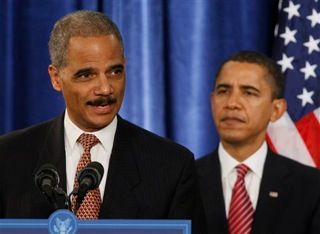
Publisher:
Bonnie King
CONTACT:
Newsroom@Salem-news.com
Advertising:
Adsales@Salem-news.com

~Truth~
~Justice~
~Peace~
TJP
May-25-2010 11:14

 TweetFollow @OregonNews
TweetFollow @OregonNews
Threat to Miranda Rule
Ralph E. Stone Salem-News.comWhy did the Supreme Court feel the need to create a universal standard?
 Attorney General Holder & President Obama |
(SAN FRANCISCO) - Recently, U.S. Attorney General Eric Holder floated proposals to carve out an exception to the Miranda rule and delay "probable cause" hearings beyond 48-hours for terrorist suspects. The proposals come in the wake of the arrest of Faisal Shahzad, the suspect in a failed attempt to detonate a car bomb in New York's Times Square. Federal interrogators questioned Mr. Shahzad for several hours before warning him of his right to remain silent and consult an attorney, citing an exception to the Miranda rule that allows such delays for immediate threats to public safety.
Ostensibly, changing the rules of the game for terrorist suspects is to allow interrogators to question them as long as needed to gather information and possibly confessions without the interruption of a 48-hour probable cause hearing. In addition, giving a Miranda warning too early might prompt a suspect to stop talking. Underlying, the proposed changes is the question of whether terrorists should be treated as war combatants in our "war against terrorists" or criminals. As war combatants, so the argument goes, terrorists should not be entitled to many of the Constitutional rights ordinary criminals enjoy. Present criminal procedures, however, are flexible enough to handle terrorism cases. If it ain't broke, don't fix it.
Miranda Rule
The genesis of the Miranda rule lies in the Fifth Amendment to the Constitution, which states in pertinent part that no person "shall be compelled in any criminal case to be a witness against himself." In the 1966 case of Miranda v. Arizona, the Supreme Court found that the Fifth Amendment and Sixth Amendment rights of Ernesto Arturo Miranda had been violated during his arrest and trial for rape and kidnapping. (Miranda was subsequently retried, found guilty and sentenced to 20–30 years.) Although the Supreme Court did not specify the exact wording to use when informing a suspect of their rights, did specify that: "The person in custody must, prior to interrogation, be clearly informed that he or she has the right to remain silent, and that anything the person says will be used against that person in court; the person must be clearly informed that he or she has the right to consult with anattorney and to have that attorney present during questioning, and that, if he or she is indigent, an attorney will be provided at no cost to represent her or him."
Since then every United States jurisdiction has enacted their own regulations, which typically state: "You have the right to remain silent. Anything you say can and will be used against you in a court of law. You have the right to an attorney. If you cannot afford an attorney, one will be appointed to you. Do you understand these rights as they have been read to you?" Most American fans of movie and television police dramas and certainly habitual criminals are now quite familiar with the Miranda warning and can probably recite it by heart. The Miranda rule requirement has not impeded good anti-terrorist police work.
The so-called Miranda rule did not create any new rights for those in custody. Rather, it simply reminds them of rights already granted to them by the Constitution. Neither interrogation alone nor arrest alone requires the suspect to be "Mirandized." It applies only when the suspect is in custody. Failure to Mirandize a suspect in custody does not result in the dismissal of the case; it just means any confession and the fruits of that confession cannot be used in evidence.
In the 1984 case of New York v. Quarles, the Supreme Court created a "public safety" exception to the requirement that officers issue Miranda warnings to suspects. In the Quarles case, after receiving the description of Quarles, an alleged assailant, a police officer entered a supermarket, spotted him, and ordered him to stop. Quarles stopped and was frisked by the officer. Upon detecting an empty shoulder holster, the officer asked Quarles where his gun was. Quarles responded. The officer then formally arrested Quarles and read him his Miranda rights. The Supreme Court reasoned that since the police officer's request for the location of the gun was prompted by an immediate interest in assuring that it did not injure an innocent bystander or fall into the hands of a potential accomplice to Quarles, his failure to read the Miranda warning did not violate the Constitution. This "public safety" exception was cited by the interrogators in the Shahzad case mentioned above.
Why did the Supreme Court feel the need to create a universal standard? The early framers of the Constitution realized how easy and tempting it was for government to obtain a confession through torture or other forms of coercion. Over the years, the courts wrestled with the problem of trying to determine what exactly was a coerced confession. Well into the Twentieth Century, police beat suspects, kept them in isolation for days, or used other methods of intimidation to obtain a confession. And some defendants just didn't know their Constitutional right to remain silent. Thus, it often made it difficult for a court to decide whether a confession was coerced or voluntary with the defendant's full knowledge of his rights. Now a failure to Mirandize a defendant will lead to the suppression of the confession.
Probable Cause Hearings
In the 1975 case of Gerstein v. Pugh, the Supreme Court ruled that the Fourth Amendment to the Constitution requires a “prompt” judicial determination of probable cause as a pre-requisite to an extended pretrial detention following a warrantless arrest. In a probable cause determination, “the sole issue is whether there is probable cause for detaining the arrested person pending further proceedings.” In the 1991 case of County of Riverside v. McLaughlin, the Supreme Court ruled that probable cause must be determined by an impartial magistrate as soon as is reasonably feasible, but in no event later than 48 hours after arrest.
Conclusion
These proposed changes severely undercut the Obama administration's announced belief in the rule of law. Too often since September 11, security has trumped individual rights. Instead of new inroads on our Constitutional rights, we need a signal from the Obama administration that our present criminal justice system is capable of handling terrorism cases without any changes. Anyway, it would be difficult for Congress to get around Supreme Court precedent. Congress has no authority to override Supreme Court Constitutional rulings.
==================================================  Salem-News.com writer Ralph E. Stone was born in Massachusetts. He is a graduate of both Middlebury College and Suffolk Law School. We are very fortunate to have this writer's talents in this troubling world; Ralph has an eye for detail that others miss. As is the case with many Salem-News.com writers, Ralph is an American Veteran who served in war. Ralph served his nation after college as a U.S. Army officer during the Vietnam war. After Vietnam, he went on to have a career with the Federal Trade Commission as an Attorney specializing in Consumer and Antitrust Law. Over the years, Ralph has traveled extensively with his wife Judi, taking in data from all over the world, which today adds to his collective knowledge about extremely important subjects like the economy and taxation. You can send Ralph an email at this address stonere@earthlink.net
Salem-News.com writer Ralph E. Stone was born in Massachusetts. He is a graduate of both Middlebury College and Suffolk Law School. We are very fortunate to have this writer's talents in this troubling world; Ralph has an eye for detail that others miss. As is the case with many Salem-News.com writers, Ralph is an American Veteran who served in war. Ralph served his nation after college as a U.S. Army officer during the Vietnam war. After Vietnam, he went on to have a career with the Federal Trade Commission as an Attorney specializing in Consumer and Antitrust Law. Over the years, Ralph has traveled extensively with his wife Judi, taking in data from all over the world, which today adds to his collective knowledge about extremely important subjects like the economy and taxation. You can send Ralph an email at this address stonere@earthlink.net
Articles for May 24, 2010 | Articles for May 25, 2010 | Articles for May 26, 2010
Quick Links
DINING
Willamette UniversityGoudy Commons Cafe
Dine on the Queen
Willamette Queen Sternwheeler
MUST SEE SALEM
Oregon Capitol ToursCapitol History Gateway
Willamette River Ride
Willamette Queen Sternwheeler
Historic Home Tours:
Deepwood Museum
The Bush House
Gaiety Hollow Garden
AUCTIONS - APPRAISALS
Auction Masters & AppraisalsCONSTRUCTION SERVICES
Roofing and ContractingSheridan, Ore.
ONLINE SHOPPING
Special Occasion DressesAdvertise with Salem-News
Contact:AdSales@Salem-News.com

googlec507860f6901db00.html



Terms of Service | Privacy Policy
All comments and messages are approved by people and self promotional links or unacceptable comments are denied.
Anonymous May 25, 2010 3:00 pm (Pacific time)
Maybe Holder should refocus his attention: Az Sheriff Wants Apology From Mexico for Its 'Threatening' Ad (Poster depicts killing Arizonans) AP News ^ | 5-24-10 An Arizona sheriff is calling on Mexican officials to apologize for what he says is a "threatening" advertisement. The ad shows a man wearing camouflage looking through binoculars with the words: "In Sonora we are looking for people from Arizona.""Are they threatening us? Do they not want us to go to Mexico for tourism? It's mindboggling," Arpaio told CNN News.com on Monday. "I don't think it was in good taste." Arpaio said he found the advertisement "inappropriate" and called on Mexican officials to apologize. "I want everybody to call the Tourism Board," Arpaio said. "To me, it's a threatening.
[Return to Top]©2025 Salem-News.com. All opinions expressed in this article are those of the author and do not necessarily reflect those of Salem-News.com.